Opening:
Did you know that the global CNC machining market is expected to reach over $100 billion by 2025? This rapid growth signifies the rising demand for advanced manufacturing techniques in various industries, particularly CNC (Computer Numerical Control) prototyping. As companies look to innovate while maintaining cost-efficiency, CNC prototyping is increasingly favored over traditional manufacturing methods. But what makes CNC prototypes so advantageous? Let’s explore in detail.
—
CNC prototyping refers to the use of computer-driven machines to create prototypes from various materials, including metals, plastics, and composites. Unlike traditional manufacturing, which often relies on manual operation and tooling, CNC technology automates the production process, allowing for precision and repeatability. This automation is revolutionizing how products are designed and manufactured, leading to significant benefits for businesses.
—
CNC machines operate within tight tolerances and dimensions, often achieving precision levels of +/
In a world that values speed, CNC prototyping shines. Traditional methods may involve longer lead times due to manual setup, tooling, and production processes. CNC machines can be programmed to produce prototypes quickly, allowing rapid iterations and shorter time-to-market. This speed gives companies a competitive edge and the opportunity to adapt their designs based on market feedback.
While traditional manufacturing might offer lower costs per unit for mass production, CNC prototyping is more economically viable for small batches. Traditional methods require expensive tooling and setups that can be prohibitive when producing limited quantities. CNC offers versatility without hefty initial investments, enabling manufacturers to create prototypes or small runs without excessive costs.
CNC machines can work with a broad spectrum of materials, from metals to engineering plastics. This versatility allows designers to choose the appropriate material for their prototypes without worrying about the limitations often found in traditional manufacturing processes. Additionally, CNC can accommodate complex geometries and designs that may otherwise be unfeasible with conventional techniques.
One of the significant drawbacks of traditional manufacturing is material waste. CNC machining optimizes material usage through efficient design and automated cutting processes, thus reducing waste and lowering material costs. This efficient approach aligns well with sustainability goals, which resonate with today’s environmentally aware consumers.
With the integration of CAD (Computer-Aided Design) software, CNC prototyping allows for complex and innovative designs. Unlike traditional manufacturing, which may struggle with intricate designs or require manual adjustments, CNC can accurately bring innovative ideas to life. This capability encourages engineers and designers to push boundaries, fostering creativity and innovation.
CNC machines can operate continuously with minimal human intervention, providing consistent results across multiple prototypes or production runs. Traditional manufacturing often suffers from variances due to human error or fatigue, making CNC appealing for applications requiring highly repetitive tasks. This consistency leads to higher quality control and reliability in the final product.
The rapid prototyping capabilities of CNC technology permit immediate modifications based on testing and evaluations. In traditional manufacturing, adjustments may necessitate a complete redo of tooling or substantial reconfiguration, which can be time-consuming and costly. In contrast, CNC allows for quick reprogramming, enabling a more agile design process.
CNC technology is becoming increasingly accessible to manufacturers of all sizes. With advancements in desktop CNC machines and affordable software solutions, small businesses and startups can now leverage CNC prototyping without the need for significant initial investments. Furthermore, as demand grows, companies can easily scale production without changing the underlying technology.
CNC manufacturers often offer extensive support and customization options. This aspect is particularly advantageous when working with unique designs or when there is a need for ongoing product iterations. Traditional manufacturing may lack the same level of adaptability and responsiveness to customer needs, making CNC a preferred choice for bespoke solutions.
—

To fully harness the advantages of CNC prototyping, manufacturers should consider the following solutions:
Ensure that your team is proficient in programming and operating CNC machines. This includes training on using CAD software and understanding machining processes. Investing in training improves accuracy, efficiency, and safety.
Collaborate with material suppliers to determine the most suitable materials for your prototypes. Testing different materials can lead to insights regarding performance, cost-effectiveness, and manufacturability.
Invest in robust CAD/CAM (Computer-Aided Manufacturing) systems to streamline the design and manufacturing process. This integration ensures that designs translate accurately and quickly into machine tool operations.
CNC machines require regular maintenance to ensure they are functioning optimally. Schedule routine checks and recalibrations to maintain accuracy and reduce downtime.
Use simulation software to pre-evaluate the machining process before it occurs. This approach helps identify issues that may arise during production and allows for corrections before the material is ever cut.
Partnering with experienced CNC service providers can enhance your prototyping efforts. These experts can provide valuable insights on best practices, machine selection, and project management.
After each prototyping phase, solicit feedback from your team and stakeholders. Analyzing this input will aid in refining designs and improving processes, leading to better outcomes in future projects.
Implement robust quality control protocols to monitor prototype accuracy. Regular quality checks should be integral to the CNC machining workflow to ensure compliance with design specifications.
Foster a culture of experimentation within your organization. Encourage teams to test new ideas and approaches, adapting their designs based on real-world data and experiences.
Emphasize sustainable practices in your CNC prototyping efforts. Prioritize sourcing environmentally friendly materials and optimizing processes to reduce energy consumption and waste.
—
As we delve deeper into the advantages of CNC prototyping, it becomes clear that this technology is not just an option but a vital component for companies looking to stay competitive in today’s fast-paced environment. From unrivaled precision and reduced lead times to enhanced material versatility and sustainability, CNC prototyping is reshaping the landscape of manufacturing.
By adopting CNC technologies and principles, businesses can innovate and respond efficiently to market demands, ultimately delivering high-quality products that meet ever-evolving customer expectations. Embracing CNC prototyping isn’t merely about following trends; it is an investment in operational excellence and future readiness.
In conclusion, understanding these advantages and adapting them to your business model is crucial. This is a pivotal time to reflect on how CNC prototypes can transform your manufacturing processes, streamline workflows, and foster innovation. As the manufacturing world leans more towards automation and precision, consider whether your operations can benefit from this powerful technology. What innovations can CNC prototyping bring to your business? Perhaps it’s time to find out.
—






